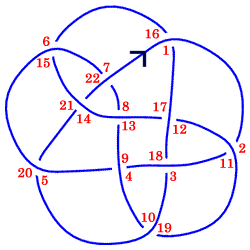DT Notation
Notations are developed to describe knot diagrams succinctly and usefully. The goal is to encode the knot diagram in a way that enables someone else to reconstruct an equivalent diagram from the code.
 The Dowker-Thistlethwaite Notation (DT Notation) of a given knot diagram can be
found by following this procedure:
The Dowker-Thistlethwaite Notation (DT Notation) of a given knot diagram can be
found by following this procedure:
Pick an arbitrary point P on the knot that is not on a crossing. Then follow the orientation of the knot to arrive at the first crossing, and label it 1. Proceed to the next crossing and label it 2. One might come across crossings that have been labeled already, but if this is the case, give it a second label. (You will never need to assign a third label, and eventually, every crossing will have two labels.)
One observes that each crossing has an even label and an odd label. The DT notation is derived by locating the odd labels in order (1, 3, 5, etc...) and recording the corresponding even labels, the signs of which are determined by whether it was an over-crossing or an under-crossing strand that had the odd label. If the odd label was assigned to an under-crossing strand, we record the corresponding even label with a negative sign.
Given the labeling in the example, the DT notation is:
16 18 20 -22 4 2 8 -6 12 10 -14